Nestled amidst the majestic peaks of the Himalayas in the Mustang District of Nepal, Muktinath Temple stands as an important pilgrimage site revered by both Hindus and Buddhists. This sacred temple, located at an altitude of 3,710 meters, offers a serene and spiritually uplifting experience for thousands of pilgrims who journey to its hallowed grounds each year. Muktinath Temple, dedicated to Lord Vishnu, the Hindu god of preservation, is an embodiment of the divine and the harmonious coexistence of two major religions, making it a unique destination for spiritual seekers.
Believed to be a place of salvation, Muktinath holds great significance for Hindus, who believe that a visit to this temple helps liberate the soul from the cycle of birth and death. For Buddhists, particularly those following the Vajrayana tradition, Muktinath is considered an important pilgrimage site as it is said to be one of the 24 Tantric places in the region.
With its awe-inspiring backdrop of the snow-capped Annapurna and Dhaulagiri mountain ranges, Muktinath Temple not only offers a profound spiritual experience but also enthralls visitors with its breathtaking natural beauty. In this article, we will delve deeper into the history, architectural marvels, spiritual significance, and practical aspects of visiting this revered temple in the mystical land of Nepal.
Muktinath Temple: A Testament to the Interwoven Spiritual Significance for Hindus and Buddhists
The Muktinath Temple is a shining beacon of religious harmony and spiritual significance for both Hindus and Buddhists, as it beautifully brings together the beliefs and traditions of these two major religions. This ancient temple is a rare example of religious coexistence, where devotees from both faiths gather to seek blessings and spiritual liberation.
For Hindus, Muktinath Temple is one of the 108 Divya Desams or holy abodes of Lord Vishnu, the god of preservation. It is believed that a pilgrimage to this sacred site can help to break the cycle of birth and death (samsara), granting salvation (moksha) to the devotees. In addition, Muktinath is one of the eight most sacred shrines in the Hindu tradition, known as the Swayam Vyakta Kshetras, where Lord Vishnu is said to have manifested himself. Devotees visiting the temple often take a ritual bath in the 108 sacred water spouts, known as Mukti Dhara, and the two holy ponds, Mukti Kunda and Saraswati Kunda, to cleanse themselves of sins and achieve spiritual purification.
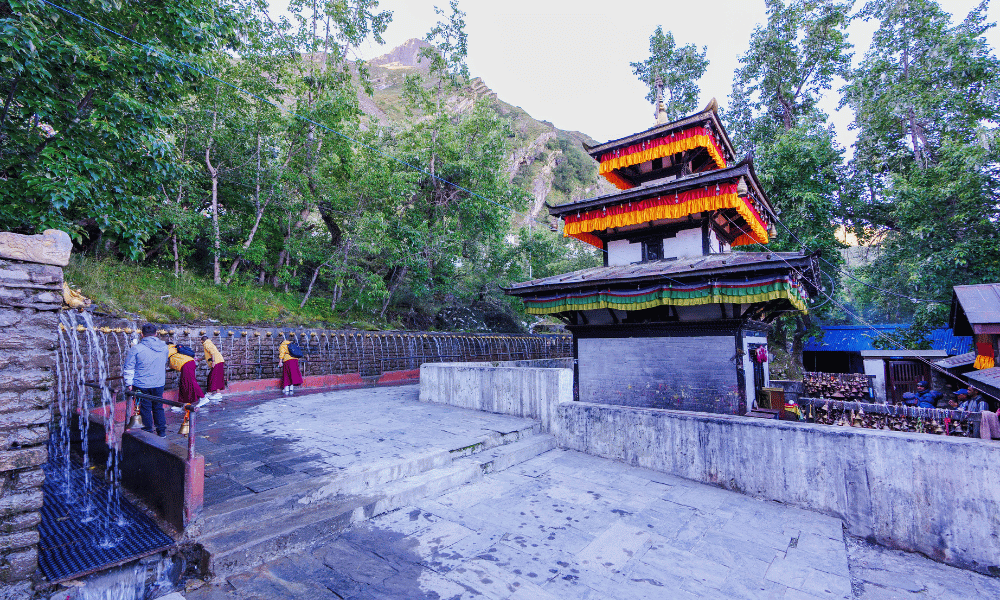
For Buddhists, particularly those following the Vajrayana tradition, Muktinath Temple holds great importance as one of the 24 Tantric places where the guru Padmasambhava, also known as Guru Rinpoche, is believed to have meditated. The presence of the temple within the Annapurna Conservation Area, which is home to numerous ancient Buddhist monasteries, further solidifies its significance within the Buddhist tradition. Buddhists believe that visiting Muktinath can help them attain spiritual enlightenment and progress on their path to achieving Buddhahood.
The harmonious coexistence of Hindu and Buddhist beliefs at Muktinath Temple is a testament to the shared spiritual heritage and mutual respect between these two ancient religions. This unique blend of religious significance, combined with the temple's awe-inspiring natural surroundings, makes Muktinath a truly special pilgrimage site for devotees from all walks of life.
Muktinath Temple: A Glimpse into its Rich History and Enchanting Location
Situated in the Mustang District of Nepal, Muktinath Temple is a prominent pilgrimage site with a rich history that dates back centuries. The temple is located at an altitude of 3,710 meters (12,172 feet) in the laps of the Annapurna and Dhaulagiri mountain ranges, making it one of the highest temples in the world.
History:
While the exact origins of Muktinath Temple are shrouded in mystery, it is believed to have existed since ancient times, with some records tracing its history back to the early 1st century AD. Over the centuries, the temple has been mentioned in various ancient Hindu and Buddhist scriptures, testifying to its significance in both religions.
Muktinath Temple is associated with numerous legends and myths, one of which tells the story of Lord Vishnu, who is said to have sought refuge in Muktinath after being cursed by a sage. Another legend involves the great Indian philosopher and theologian Adi Shankaracharya, who is believed to have visited the temple in the 8th century AD and established it as one of the most important pilgrimage sites for Hindus.
Throughout history, the temple has attracted rulers and devotees from different dynasties and regions, who have contributed to its development and preservation. Muktinath has also played a crucial role in the cultural exchange between India and Tibet, as it lies along an ancient trade route that facilitated the movement of people, goods, and ideas between these two regions.
Location:
Muktinath Temple is located near the village of Ranipauwa in the Mustang District of Nepal, about 180 kilometers (110 miles) from the city of Pokhara. The temple is situated within the Annapurna Conservation Area, which is known for its diverse landscapes, ranging from lush forests to arid deserts, and is home to a rich variety of flora and fauna.
Reaching Muktinath Temple can be an adventurous journey, as it requires traversing rugged terrains and navigating through high altitudes. Many pilgrims and trekkers choose to visit the temple as part of the famous Annapurna Circuit trek, which offers an unparalleled experience of Nepal's natural beauty and cultural heritage.
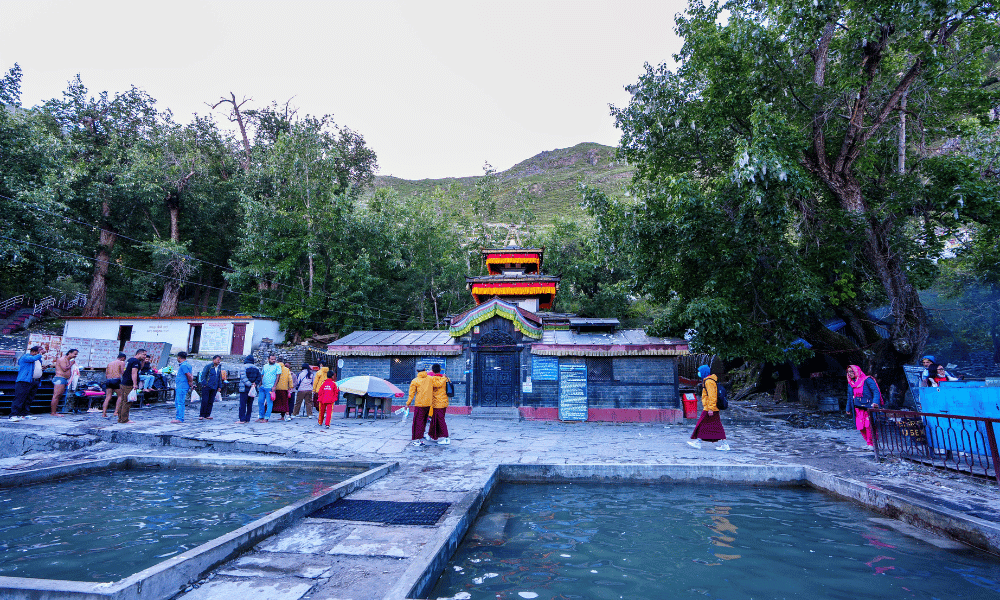
Muktinath Temple's rich history and its location amidst the stunning landscapes of the Annapurna and Dhaulagiri mountain ranges make it an enticing pilgrimage site for devotees and adventure seekers alike. Its significance in both Hindu and Buddhist traditions adds to the allure, making it a must-visit destination for anyone seeking spiritual enlightenment and a connection with the divine.
Related Article: Muktinath Temple Photos
History
The history of Muktinath Temple dates back thousands of years, with its ancient origins deeply rooted in Hindu and Buddhist mythology. Surrounded by legends and tales of divine intervention, the temple has played a significant role in the cultural exchange between India and Tibet. Over the centuries, various dynasties and rulers have contributed to the development and prominence of the temple, enhancing its spiritual allure for pilgrims. The sacred Muktinath Temple serves as a testament to the region's rich cultural heritage and its enduring significance as a revered pilgrimage site for both Hindus and Buddhists.
Ancient Origins of Muktinath Temple:
The exact origins of Muktinath Temple are shrouded in mystery, with historical accounts tracing its existence back to ancient times. Some records suggest that the temple has been a place of worship since the early 1st century AD. Over the centuries, Muktinath has been mentioned in various Hindu and Buddhist scriptures, emphasizing its religious and historical significance.
Legends and Myths Surrounding Muktinath Temple:
Numerous legends and myths are associated with Muktinath Temple, adding to its allure and mystique. One such legend involves Lord Vishnu, who is said to have sought refuge in Muktinath after being cursed by a sage. It is believed that Vishnu took the form of a Saligram (a sacred black stone) to reside in Muktinath, and devotees continue to worship him in this form.
Another legend tells the story of the great Indian philosopher and theologian Adi Shankaracharya, who visited the temple in the 8th century AD. It is said that Shankaracharya recognized Muktinath as a powerful spiritual site and established it as one of the most important pilgrimage destinations for Hindus.
Dynasties and Rulers Contributing to Muktinath Temple's Development:
Over the centuries, Muktinath Temple has attracted rulers and devotees from different dynasties and regions, who have contributed to its development and preservation. The Malla dynasty, which ruled over parts of Nepal between the 12th and 18th centuries, played a significant role in the temple's construction and expansion. Later, the Shah dynasty, which united Nepal and established the Kingdom of Nepal, also made considerable contributions to the temple's development.
Apart from these dynasties, Muktinath has been patronized by rulers from India and Tibet, who have made offerings, renovations, and expansions to the temple complex, testifying to its religious and cultural importance.
Muktinath Temple's Role in the Cultural Exchange between India and Tibet:
Muktinath Temple has played a crucial role in facilitating the cultural exchange between India and Tibet, as it lies along an ancient trade route that connected these two regions. This route, known as the Salt Trade Route or the Kali Gandaki Trade Route, enabled the movement of people, goods, and ideas, allowing for the exchange of religious, cultural, and artistic influences.
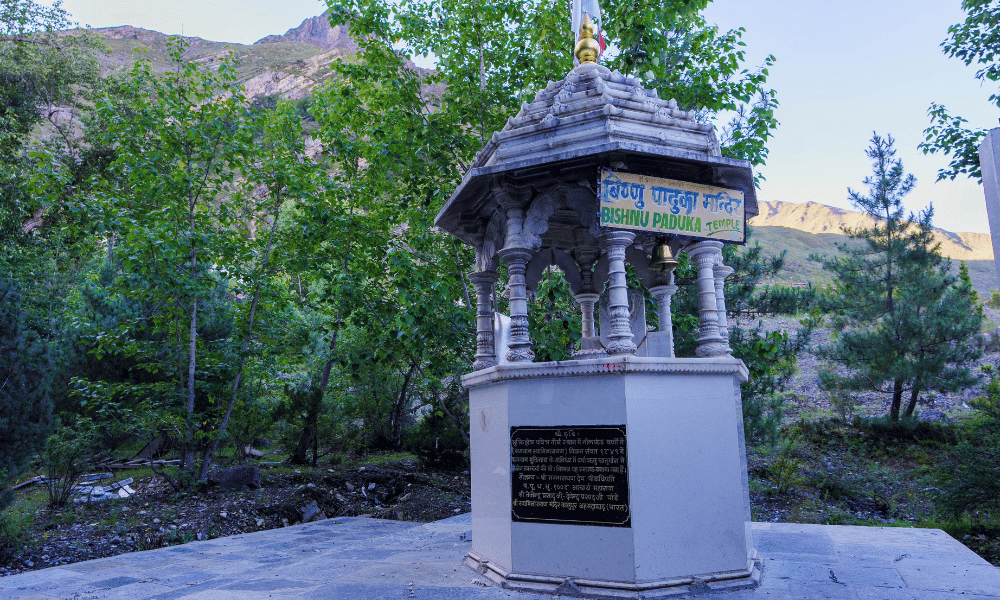
The temple's location along this trade route made it an important center for pilgrimage and cultural exchange. Devotees and traders from both India and Tibet would stop at Muktinath to pay their respects, rest, and exchange goods, stories, and knowledge. This interaction between different cultures has contributed to the unique blend of Hindu and Buddhist elements found at Muktinath Temple, making it a symbol of religious harmony and cultural exchange.
In conclusion, the history of Muktinath Temple is marked by ancient origins, intriguing legends, and the patronage of various dynasties and rulers. Its unique location along an important trade route has allowed the temple to become a nexus of cultural exchange between India and Tibet, creating a beautiful fusion of religious traditions and beliefs.
An Architectural Marvel
Dedicated to Lord Vishnu. A standout feature of the temple is the 108 water spouts, which hold immense spiritual significance and are believed to cleanse sins when bathed under. The Jwala Mai Temple, with its mysterious eternal flame, further adds to the complex's spiritual allure. Together, these diverse and awe-inspiring structures create a rich tapestry of sacred architecture that captivates pilgrims and visitors alike.
Overview of the Muktinath Temple Complex:
The Muktinath Temple complex is an architectural marvel that showcases a fascinating fusion of Hindu and Buddhist elements. The main components of the complex include the central shrine dedicated to Lord Vishnu, the 108 water spouts, the Jwala Mai Temple, and numerous smaller shrines and structures. The temple is surrounded by a wall, which separates the sacred space from the outside world, and is adorned with intricate carvings and sculptures that reflect the religious and artistic influences of its diverse patrons.
Architectural Style and Unique Features of Muktinath Temple:
Muktinath Temple exhibits a blend of architectural styles, with influences from both the Indian subcontinent and the Himalayan region. The central shrine is built in a pagoda style, featuring a multi-tiered roof and ornate wooden carvings. The shrine houses the main deity, Lord Vishnu, in the form of a Saligram, which is a sacred black stone representing the god. In addition to the main shrine, there are several smaller shrines and structures throughout the complex, each with its own unique features and artistic details.
One of the most striking features of the temple complex is its metalwork, which includes the 108 water spouts and the brass and bronze statues of various deities. These metal elements not only showcase the skilled craftsmanship of the artists but also hold deep religious significance for the devotees who visit the temple.
The 108 Water Spouts and Their Significance:
One of the most distinctive features of Muktinath Temple is the 108 water spouts, known as Mukti Dhara, arranged in the shape of a semi-circle. These spouts, made of brass, are carved with the heads of various animals, such as lions, horses, and cows. The water that flows through these spouts is believed to have originated from the sacred Gosainkunda Lake and is considered to possess purifying qualities.

The number 108 holds great significance in Hinduism and Buddhism, symbolizing the universe, spiritual growth, and the steps on the path to enlightenment. Devotees visiting the temple take a ritual bath under these 108 water spouts to cleanse themselves of sins and achieve spiritual purification.
Jwala Mai Temple and Its Eternal Flame:
Another noteworthy feature of the Muktinath Temple complex is the Jwala Mai Temple, which is dedicated to the goddess Jwala Devi. The temple is famous for its eternal flame, which is said to burn continuously from a natural gas source. This flame is believed to represent the divine power of the goddess, and devotees visit the temple to seek her blessings and protection. The Jwala Mai Temple is also revered by Buddhists, who believe that Guru Rinpoche meditated in the temple's vicinity during his journey through the region.
Other Noteworthy Structures and Shrines within the Complex:
In addition to the main temple and its prominent features, the Muktinath Temple complex is home to several other shrines and structures. These include smaller temples dedicated to various Hindu and Buddhist deities, such as Laxmi, Saraswati, Ganesha, and Avalokiteshvara. There are also several ancient Buddhist monasteries and meditation caves within the complex, which serve as important centers for spiritual practice and learning.
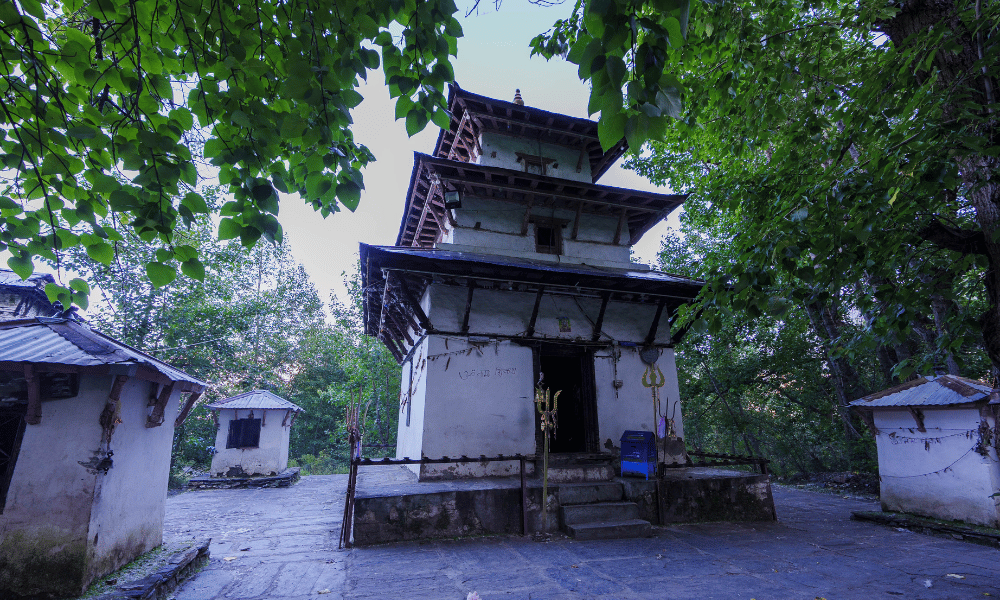
In summary, the Muktinath Temple complex is an architectural marvel that showcases a beautiful fusion of Hindu and Buddhist elements. With its unique features such as the 108 water spouts, the eternal flame of the Jwala Mai Temple, and various other shrines and structures.
Spiritual Significance
The spiritual significance of Muktinath Temple is deeply rooted in its connections to both Hinduism and Buddhism. For Hindus, the temple is a sacred abode of Lord Vishnu, who is believed to grant salvation or liberation to devotees. In Buddhism, the temple holds particular importance in the Vajrayana tradition, with its association to Guru Rinpoche. The concept of "Muktinath," the god of salvation, plays a vital role in the spiritual beliefs of pilgrims who seek liberation from the cycle of birth and death. Furthermore, the temple's location along the Annapurna Circuit trek adds to its significance, as trekkers often find a sense of spiritual solace amidst the breathtaking natural beauty of the region.
Importance of Muktinath Temple in Hinduism and Its Association with Lord Vishnu:
Muktinath Temple holds immense spiritual significance for Hindus, as it is one of the 108 Divya Desams or holy abodes of Lord Vishnu, the god of preservation. The temple is dedicated to Lord Vishnu in the form of a Saligram, a sacred black stone that represents the deity. Muktinath is also one of the eight most sacred shrines in Hinduism, known as the Swayam Vyakta Kshetras, where Lord Vishnu is believed to have manifested himself.
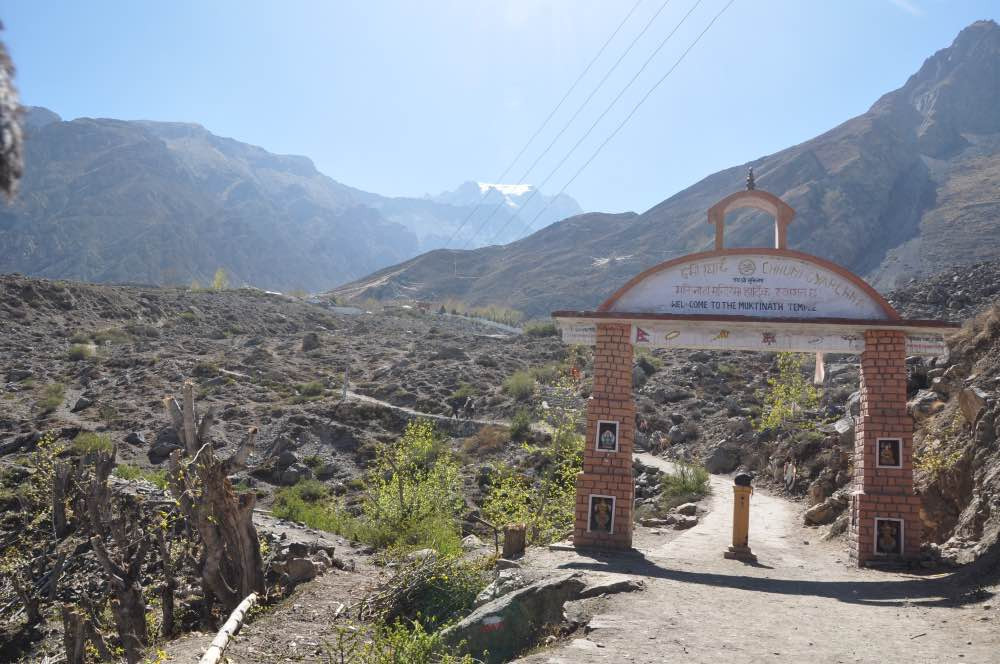
For Hindus, a pilgrimage to Muktinath is thought to grant salvation or moksha, which is the release from the cycle of birth and death (samsara). This belief stems from the concept of "Muktinath," which translates to "the god of salvation." As a result, thousands of Hindu pilgrims journey to the temple each year to seek the blessings of Lord Vishnu and attain spiritual liberation.
Significance of Muktinath Temple in Buddhism and the Vajrayana Tradition:
For Buddhists, particularly those following the Vajrayana tradition, Muktinath Temple is considered an important pilgrimage site. The temple is said to be one of the 24 Tantric places where Guru Rinpoche, also known as Padmasambhava, meditated during his travels in the region. This connection to Guru Rinpoche makes Muktinath an important destination for Buddhists seeking spiritual growth and enlightenment.
In addition, the presence of the temple within the Annapurna Conservation Area, which is home to numerous ancient Buddhist monasteries, further solidifies its significance within the Buddhist tradition.
The Concept of "Muktinath" and Its Role in the Spiritual Beliefs of Pilgrims:
The concept of "Muktinath" as the god of salvation plays a central role in the spiritual beliefs of pilgrims who visit the temple. Both Hindus and Buddhists believe that paying homage to Muktinath can help them attain spiritual liberation and progress on their respective spiritual paths.

For Hindus, the temple's association with Lord Vishnu and the release from the cycle of birth and death (samsara) is a primary reason for visiting Muktinath. For Buddhists, the temple's connection to Guru Rinpoche and the attainment of spiritual enlightenment make it a significant destination for pilgrimage.
Muktinath Temple's Significance in the Broader Context of the Annapurna Circuit Trek:
Muktinath Temple is not only a revered pilgrimage site but also an essential stop along the famous Annapurna Circuit trek. This trek takes adventurers through diverse landscapes, including lush forests, alpine meadows, and arid desert regions, providing a unique and immersive experience of Nepal's natural beauty and cultural heritage.
The spiritual significance of Muktinath Temple adds a unique dimension to the Annapurna Circuit trek, offering trekkers an opportunity to explore the region's rich spiritual history and engage with the local communities that call the area home. In this context, Muktinath serves as both a spiritual destination and a gateway to the incredible experiences that the Annapurna region has to offer.
In conclusion, the spiritual significance of Muktinath Temple lies in its deep connections to both Hinduism and Buddhism, as well as its broader context within the Annapurna Circuit trek. Its association with Lord Vishnu, Guru Rinpoche, and the concept of spiritual liberation make it an essential destination for pilgrims and trekkers seeking a deeper understanding of the people.
A Pilgrim's Guide
A pilgrimage to Muktinath Temple requires careful planning and preparation. The best time to visit the temple is during spring (March to May) and autumn (September to November) when the weather is most favorable for trekking. Reaching the temple involves a combination of flights, road transportation, and trekking, with the option of a shorter journey via Jomsom or a longer trek along the Annapurna Circuit. Acclimatizing to the high altitude is essential for a safe and enjoyable experience, and visitors can find accommodations ranging from basic teahouses to more comfortable lodges in the Muktinath area. By following these guidelines, pilgrims can ensure a memorable and spiritually enriching journey to one of Nepal's most revered temples.
Check our multiple Muktinath packages and contact us for any kind of customized trip to Muktinath.
Best Time to Visit Muktinath Temple:
The best time to visit Muktinath Temple is during the months of March to May (spring) and September to November (autumn). During these periods, the weather is generally clear and stable, providing excellent trekking conditions and visibility. The monsoon season, from June to August, is best avoided, as the heavy rainfall can make trekking difficult and increase the risk of landslides. Winter months, from December to February, are also less ideal due to cold temperatures and potential snowfall, which can make the high-altitude trekking more challenging.
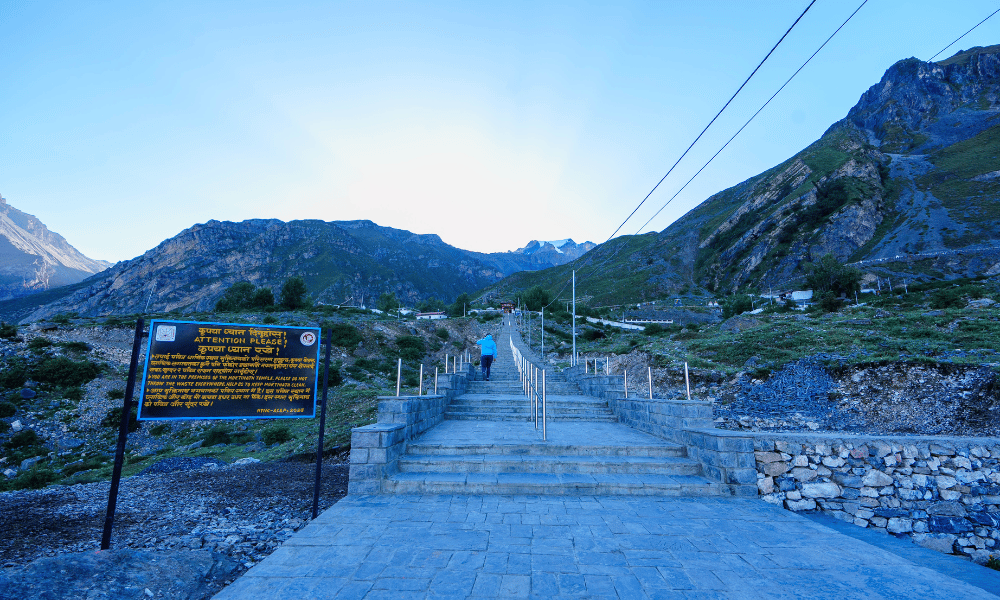
Step-by-Step Guide to Reaching Muktinath Temple:
To reach Muktinath Temple, you will need to follow a series of steps, which may include a combination of flights, road transportation, and trekking. Here's a step-by-step guide to help you plan your journey:
First : Fly to Tribhuvan International Airport in Kathmandu, Nepal.
Second : Take a domestic flight from Kathmandu to Pokhara, which is approximately a 30-minute journey.
Third : From Pokhara, you have two main options to reach Muktinath Temple:
Option 1 (Flight and Drive): Fly to Jomsom Airport and then hire a jeep to Muktinath Temple. The flight takes around 20 minutes, while a jeep ride takes around 1 hour. After the jeep reaching point you need to walk about 2 KM (20-30 Minutes) to reach the temple area.
Option 2 (Drive): Drive from Pokhara, which will take you through various villages and landscapes, eventually leading you to Muktinath Temple. This option is more time-consuming and off road difficult drive as the drive can take 8-10 hours, depending on the road condition, time period of travel and traffic.
Tips for Acclimatizing and Staying Safe During the Journey:
High altitude is one of the main challenges you may face during your journey to Muktinath Temple. Here are some tips to help you acclimatize and stay safe:
- Ascend slowly: Give your body time to adjust to the high altitude by gradually increasing your elevation each day.
- Stay hydrated: Drink plenty of water and avoid alcohol and caffeine, which can exacerbate dehydration.
- Rest and sleep well: Ensure you get adequate rest and a good night's sleep to help your body recover from the day's exertions.
- Know the signs of altitude sickness: Be aware of the symptoms of altitude sickness, such as headache, nausea, dizziness, and shortness of breath. If you experience any of these symptoms, consider descending to a lower altitude until you feel better.
Accommodations and Local Cuisine Options in the Muktinath Area:
In the Muktinath area, you will find a range of accommodations, from basic teahouses to more comfortable guesthouses and lodges. Most accommodations offer a simple but cozy atmosphere, with traditional Nepali hospitality.
The local cuisine in the Muktinath region primarily consists of Nepali and Tibetan dishes. Some popular options include dal bhat (rice with lentil soup), momos (steamed dumplings), and thukpa (noodle soup). Many accommodations also offer a variety of international dishes to cater to the diverse tastes of travelers.
In conclusion, visiting Muktinath Temple requires careful planning and consideration of factors such as the best time to visit, transportation options, acclimatization, and local accommodations.
Responsible Tourism
While visiting Muktinath Temple, it is crucial to respect local customs and traditions to ensure a harmonious experience for both visitors and the local community. As a sacred site for Hindus and Buddhists, Muktinath Temple demands a certain level of reverence and cultural sensitivity from its visitors. By understanding and adhering to the appropriate behaviors and customs, you can help preserve the sanctity of the site and foster a positive relationship with the local people.
Guidelines for Appropriate Behavior and Attire:
In and around the Muktinath Temple complex, follow these guidelines to ensure appropriate behavior and attire:
- Dress modestly: Both men and women should wear clothing that covers their shoulders and knees, as revealing attire is considered disrespectful in religious spaces. Avoid wearing shorts, sleeveless shirts, or tight clothing.
- Remove shoes: Before entering any temple or shrine, it is customary to remove your shoes as a sign of respect.
- Show respect: When inside the temple complex, maintain a quiet and respectful demeanor. Avoid loud conversations or engaging in any behavior that may disturb the tranquility of the space.
- Photography: Be mindful when taking photographs. Avoid photographing the main deity in the temple or any other religious ceremonies without permission. Always ask for consent before taking pictures of the local people.
- Do not touch sacred objects: Refrain from touching any sacred objects, statues, or relics within the temple complex.
Sustainable Tourism Practices and Their Impact:
Sustainable tourism practices are essential for preserving the local community and environment in the Muktinath region. By adopting eco-friendly practices and supporting the local economy, you can minimize your impact on the area and contribute to its long-term preservation. Here are some sustainable tourism practices to consider:
- Minimize waste: Carry reusable items, such as water bottles, bags, and utensils, to reduce plastic waste. Properly dispose of your trash and, whenever possible, carry it back with you to urban areas where waste management facilities are more accessible.
- Conserve resources: Be mindful of your water and energy consumption, particularly in high-altitude areas where resources are scarce. Use water sparingly and turn off lights and electrical devices when not in use.
- Support local businesses: Choose locally-owned accommodations, restaurants, and shops to support the local economy and ensure that the benefits of tourism are shared within the community.
- Respect wildlife: Maintain a safe distance from wildlife and avoid feeding or disturbing them. Stick to designated trails to minimize your impact on the natural environment.
The responsible tourism and cultural sensitivity are essential aspects of visiting Muktinath Temple. By respecting local customs and traditions, adopting appropriate behavior and attire, and embracing sustainable tourism practices, you can contribute to the preservation of this sacred site and the well-being of the local community and environment.
Conclusion
Throughout this article, we have explored the many facets of Muktinath Temple, delving into its history, architectural marvels, spiritual significance, and practical aspects of planning a pilgrimage. We have also emphasized the importance of responsible tourism and cultural sensitivity to ensure a harmonious and sustainable experience for both visitors and the local community.
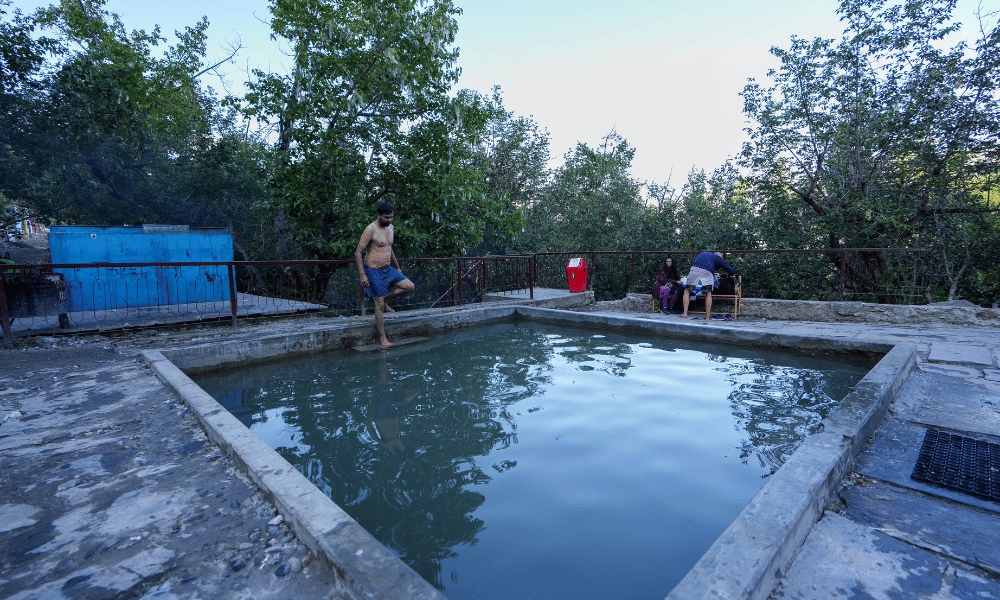
To recap, some of the main points covered include:
- The ancient origins and legends surrounding Muktinath Temple, and its role in the cultural exchange between India and Tibet
- The unique architectural features of the temple complex, such as the 108 water spouts and the Jwala Mai Temple's eternal flame
- The spiritual significance of Muktinath Temple for both Hindus and Buddhists, and its connection to the concept of spiritual liberation
- A step-by-step guide for planning your journey to the temple, along with tips for acclimatizing to the high altitude and finding accommodations
- The importance of respecting local customs, adopting appropriate behavior and attire, and embracing sustainable tourism practices
We encourage you to embark on your own spiritual journey to Muktinath Temple and experience firsthand the rich cultural heritage and spiritual significance of this ancient site. As you walk the same paths as countless pilgrims before you, may you find a sense of wonder and appreciation for the timeless allure and sacredness of this remarkable temple.

